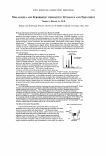102 JOURNAL OF COSMETIC SCIENCE Redness ■ group 1 □ group2 5 4 3 0 a 2 0 Baseline day3 day5 day7 Days of treatment Oily ■ group l □ group2 5 4 II,) 3 0 � 2 ::E 0 Baseline day3 day5 day7 Days of treatment Dark pigmentation ■ group 1 D group2 5 4 3 0 II,) ::E 0 Baseline day3 day5 day7 Days of treatment Figure 2. Improvement in the mean of scale assessed by patients after treatment with Acne Dressing® (group 1) or skin tapes (group 2).
300 250 200 150 .£ 100 0 50 s :::, .0 0 EFFICACY TREATMENT OF ACNE VULGARIS Baseline day3 da 5 Day of tr atm nt -+- group I --- group2 103 day7 Figure 3. Improvement in assessment of sebum casual level by patients after treatment with Acne Dress- ing® (group 1) or skin tapes (group 2). 4t' - - 36 ----- .--- I V I �� I kin type I I I I I I I is ,-� '1 .r-' I � -- � -• .... t., ... I :c 1� rt ., /I I"\. I J UVB '\ ·/ "'1 / V I I I I 1: I I I I $ I I j I " Acne Dressing I / r\ I �-/ ___, � t'C, .21 2:0 Z!O 2-'0 �SC 2S1 270 1 0 29C !CO 310 31C 330 �40 351) W ,1\"al-tnlft, (nm) Figure 4. Ultraviolet transmission test of Acne Dressing® and skin tapes. As Mandan et al. (13) point out, the reduction in sebum production, cell proliferation, and anti-inflammation activity leads to a visible improvement of the skin condition, without leaving scars or provoking irritation or other side effects. A significant decrease (p 0.05) in the sebum casual level on the treated acne was seen at clay 7 after treatment with Acne Dressing®·. The resultant effect in sebum absorption and the gradual decrease of sebum was helpful in reducing the inflammation. Some studies have indicated that sebum has a central role in the pathogenesis of acne and that the severity of acne is
Purchased for the exclusive use of nofirst nolast (unknown) From: SCC Media Library & Resource Center (library.scconline.org)










































































































